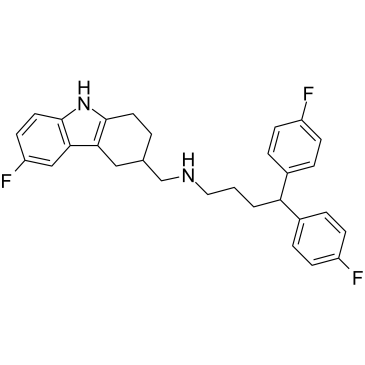MSC1094308 (MSC-1094308) is a novel and potent allosteric inhibitor of the type II AAA ATPase. AAA ATPases play critical roles in a variety of cellular processes necessary for survival and growth.
Physicochemical Properties
| Molecular Formula | C29H29F3N2 |
| Molecular Weight | 462.549177885056 |
| Exact Mass | 462.23 |
| Elemental Analysis | C, 75.30; H, 6.32; F, 12.32; N, 6.06 |
| CAS # | 2219320-08-6 |
| PubChem CID | 139035043 |
| Appearance | Off-white to pink solid powder |
| LogP | 7 |
| Hydrogen Bond Donor Count | 2 |
| Hydrogen Bond Acceptor Count | 4 |
| Rotatable Bond Count | 8 |
| Heavy Atom Count | 34 |
| Complexity | 595 |
| Defined Atom Stereocenter Count | 0 |
| InChi Key | OCZIMUMAPGQEBH-UHFFFAOYSA-N |
| InChi Code | InChI=1S/C29H29F3N2/c30-22-8-4-20(5-9-22)25(21-6-10-23(31)11-7-21)2-1-15-33-18-19-3-13-28-26(16-19)27-17-24(32)12-14-29(27)34-28/h4-12,14,17,19,25,33-34H,1-3,13,15-16,18H2 |
| Chemical Name | 4,4-bis(4-fluorophenyl)-N-[(6-fluoro-2,3,4,9-tetrahydro-1H-carbazol-3-yl)methyl]butan-1-amine |
| Synonyms | MSC-1094308; MSC1094308; MSC 1094308 |
| HS Tariff Code | 2934.99.9001 |
| Storage |
Powder-20°C 3 years 4°C 2 years In solvent -80°C 6 months -20°C 1 month |
| Shipping Condition | Room temperature (This product is stable at ambient temperature for a few days during ordinary shipping and time spent in Customs) |
Biological Activity
| Targets | VPS4B ( IC50 = 0.71 μM ); p97 ( IC50 = 7.2 μM ) |
| ln Vitro | In HCT116 cells, polyubiquitin accumulation is induced by MSC1094308 (10 μM; 8 hours) as a biomarker of homeostatic inhibition [1]. |
| Cell Assay |
Western Blot Analysis[1] Cell Types: HCT116 cells Tested Concentrations: 10 µM Incubation Duration: 8 h Experimental Results: Resulting in the accumulation of polyubiquitinated proteins (biomarkers of degradation inhibition). |
| References |
[1]. A Non-Competitive Inhibitor of VCP/p97 and VPS4 Reveals Conserved Allosteric Circuits in Type I and II AAA ATPases. Angew Chem Int Ed Engl. 2018 Feb 5;57(6):1576-1580. |
Solubility Data
| Solubility (In Vitro) | DMSO: ~50 mg/mL (~108.1 mM) |
| Solubility (In Vivo) |
Solubility in Formulation 1: ≥ 2.5 mg/mL (5.40 mM) (saturation unknown) in 10% DMSO + 40% PEG300 + 5% Tween80 + 45% Saline (add these co-solvents sequentially from left to right, and one by one), clear solution. For example, if 1 mL of working solution is to be prepared, you can add 100 μL of 25.0 mg/mL clear DMSO stock solution to 400 μL PEG300 and mix evenly; then add 50 μL Tween-80 to the above solution and mix evenly; then add 450 μL normal saline to adjust the volume to 1 mL. Preparation of saline: Dissolve 0.9 g of sodium chloride in 100 mL ddH₂ O to obtain a clear solution. Solubility in Formulation 2: ≥ 2.5 mg/mL (5.40 mM) (saturation unknown) in 10% DMSO + 90% (20% SBE-β-CD in Saline) (add these co-solvents sequentially from left to right, and one by one), clear solution. For example, if 1 mL of working solution is to be prepared, you can add 100 μL of 25.0 mg/mL clear DMSO stock solution to 900 μL of 20% SBE-β-CD physiological saline solution and mix evenly. Preparation of 20% SBE-β-CD in Saline (4°C,1 week): Dissolve 2 g SBE-β-CD in 10 mL saline to obtain a clear solution. Solubility in Formulation 3: ≥ 2.5 mg/mL (5.40 mM) (saturation unknown) in 10% DMSO + 90% Corn Oil (add these co-solvents sequentially from left to right, and one by one), clear solution. For example, if 1 mL of working solution is to be prepared, you can add 100 μL of 25.0 mg/mL clear DMSO stock solution to 900 μL of corn oil and mix evenly. (Please use freshly prepared in vivo formulations for optimal results.) |
| Preparing Stock Solutions | 1 mg | 5 mg | 10 mg | |
| 1 mM | 2.1619 mL | 10.8096 mL | 21.6193 mL | |
| 5 mM | 0.4324 mL | 2.1619 mL | 4.3239 mL | |
| 10 mM | 0.2162 mL | 1.0810 mL | 2.1619 mL |
